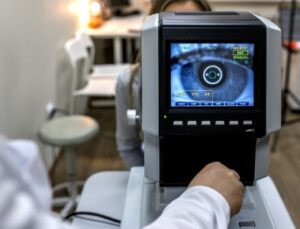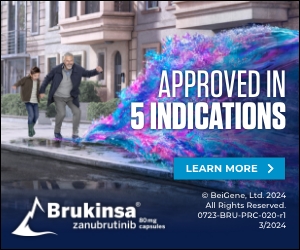
VA’s Technology Based Eye Care Services (TECS) Tele-glaucoma program enables veterans to receive routine eye appointments and specialized appointments from their community-based outpatient clinic rather than having to travel long distances to the main VA facility to see the specialist in person.VA photo
ATLANTA — Veteran patients nationwide who received care from Technology-based Eye Care Services (TECS), a tele-ophthalmology program operating in the VHA, reported having a favorable experience. They were often diagnosed with vision threatening disease in earlier stages so that permanent vision loss could be prevented, according to a recent study.
The study published in Ophthalmology explored characteristics of the national TECS patient population and evaluated implementation and sustainability of TECS. The researchers also investigated possible associations and effects of demographic characteristics and social determinants of health on being diagnosed with a vision-threatening disease.1
Study authors are affiliated with Emory University School of Medicine and the Morehouse School of Medicine, both in Atlanta; the Veterans Integrated Service Network 23 in Minneapolis; the Ralph H. Johnson VAMC in Charleston, SC; and the National Cancer Institute and the National Institutes of Health, both in Bethesda, MD.
TECS, an ophthalmologic telemedicine program, includes the standard ocular history questions, vision, refraction, eye pressure and photographs combined into one comprehensive protocol. In this study, researchers examined the implementation and sustainability of TECS from 2015 to 2022. They also analyzed data on veteran patients seen in TECS nationwide to determine sociodemographic characteristics of these patients in 2021, the authors explained.
“Veteran patients love the TECS program,” April Y. Maa, MD, professor of ophthalmology at Emory University School of Medicine and director of Technology-based Eye Care Services (TECS) at Veterans Integrated Service Network 23 of the VHA, told U.S. Medicine. “Regular anonymous patient surveys administered by VA telehealth routinely show incredibly high satisfaction rates and trust in the care delivery model.”
“The program allows them to receive high quality eye care in their primary care clinics, and this veteran can be served as a ‘one-stop shop,’” Maa said. “A TECS visit provides them with eyeglasses to improve their quality of life as well as provide them a comprehensive ocular health examination to ensure that their eyes are healthy. This telehealth program absolutely diagnosed vision threatening disease, often in the earlier stages, where interventions are much more effective at preventing permanent vision loss.”
This study found that 21,712 veterans were served by TECS in 2021, and 52.1% were in rural or highly rural areas. The average age of patients was 64.7 years, and 10.9% of the veterans served were women. In this patient population, 61.4% were Non-Hispanic White, 29.5% were Non-Hispanic Black, 1.7% were Hispanic, and the remaining veterans were Asian, Indian or unknown. In addition, 8.3% of the veterans served were homeless, the study reported.
Study authors also concluded that implementation and sustainability rates of TECS are high. From 2015 to 2022, 67 TECS sites were initiated nationwide. Six were implementing, and 51 of 61 initiated sites were still operational in the first quarter of 2022.
The investigators chose to study the national experience of TECS because it has been a care modality within the VA for nearly 10 years. Evaluating the TECS program ensures that program results are replicable across the nation, identifies appropriate next steps and how to best allocate resources, evaluates the impact the program has on reducing health disparities, and determines whether TECS was able to promote health equity, Maa explained.
“Our paper found that TECS does reduce healthcare disparities for veterans,” Maa suggested. “Rurality was the most common predictor for two things:
- likelihood of being diagnosed at a more severe stage of eye disease and
- being more likely to have more than one co-morbid eye condition (e.g., diabetes and glaucoma) compared to urban veterans.”
“Very few studies can show this, so what we know is that because the TECS program was in rural areas, we were able to provide care to a population that wasn’t getting regular access to care, thereby reducing healthcare disparities and preventing blindness in these vulnerable populations. Vulnerable populations studied included rural, highly rural and homeless veterans,” she said.
This study determined that age-related macular degeneration and cataracts were more prevalent in rural and highly rural populations (7.6% and 11.3%, and 48.8% and 55.0%, respectively) versus urban populations (5.8% and 47.8%). Glaucoma and diabetic retinopathy had the opposite association, according to the investigators.
The Mountains/Central region of the U.S. had the lowest prevalence of any type of vision threatening eye disease (0.54%), and the Southeast region had the highest prevalence of vision threatening eye disease (3.2%). Also, rural and highly rural residents were 1.3 and 2.5 times as likely, respectively, to be diagnosed with a vision threatening eye disease compared to urban residents, the researchers pointed out.
For healthcare professionals who are contemplating setting up a TECS site, Maa encourages them to strongly consider adding this tool to help reach their vulnerable veteran populations and reduce healthcare expenditures. The research team has several evidence-based papers and quality data that show the effectiveness of the program, and results are similar across the country, Maa noted.
“Telehealth programs promote health equity and provide critical access points for our veterans and should be leveraged as a tool in the toolbox to care for our nation’s heroes/sheroes,” she added. “Now that VA has a network of TECS sites, we can utilize the same infrastructure to deliver even more eye care to veterans. We can deliver both screening eye care and medical management of eye disease. Our next steps are to extend the model and provide subspecialty ophthalmology services to our rural veterans—retina, glaucoma and neuro-ophthalmology.”
“This will promote even better health equity because these subspecialists are really needed for the veterans and yet are concentrated in the urban area, making access to these services very difficult,” according to Maa. She made note of certified ophthalmic technicians who are integral to the care team.
- Simon LS, Davis ML, Medunjanin D, Fanning L, Damonte JC, Hunt K, Maa AY. National Experience of Technology-based Eye Care Services: A Comprehensive Ophthalmology Telemedicine Initiative. Ophthalmology. 2024 Oct 4:S0161-6420(24)00602-X. doi: 10.1016/j.ophtha.2024.09.032. Epub ahead of print. PMID: 39368749.


